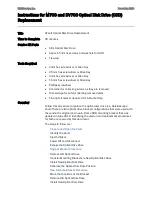
104
DS6000 Series: Concepts and Architecture
Global Copy (PPRC-XD)
Description
Global Copy is a function for continuous copy without data consistency.
Advantages
It can copy your data at nearly an unlimited distance, even if you are limited by the
network and channel extender capabilities. It is suitable for data migration and daily
backup to the remote site.
Considerations
The copy is normally
fuzzy
but can be made consistent through synchronization.
Global Mirror (Asynchronous PPRC)
Description
Global Mirror is an asynchronous copy; you can create a consistent copy in the secondary
site with an adaptable Recovery Point Objective (RPO).
Advantages
Global Mirror can copy over nearly an unlimited distance. It is scalable across the server
enclosures. It can realize low RPO with enough link bandwidth. Global Mirror causes little
or no impact to your application system.
Note:
If you want to use PPRC for mirroring, you need to compare its function with OS
mirroring.
Generally speaking, you will have some disruption to recover your system with PPRC
secondary volumes in an open systems environment because PPRC secondary volumes
are not online to the application servers during the PPRC relationship.
You may need some operations before assigning PPRC secondary volumes. For example,
in an AIX environment, AIX assigns specific IDs to each volume (PVID). PPRC secondary
volumes have the same PVID as PPRC primary volumes. AIX cannot manage the volumes
with the same PVID as different volumes. Therefore, before using the PPRC secondary
volumes, you need to clear the definition of the PPRC primary volumes or reassign PVIDs
to the PPRC secondary volumes.
Some operating systems (OS) or file systems (for example, AIX LVM) have a function for
disk mirroring. OS mirroring needs some server resources, but usually can keep operating
with the failure of one volume of the pair and recover from the failure non-disruptively. If
you use PPRC for the mirroring in the local site only, you need to consider which solution
(PPRC or OS mirroring) is better for your system.
Note:
When you operate to create a consistent copy for Global Copy, you need the
go-to-sync (synchronize the secondary volumes to the primary volumes) operation. During
the go-to-sync operation, PPRC changes from a non-synchronous copy to a synchronous
copy. Therefore, the go-to-sync operation may cause performance impact to your
application system. If the data is heavily updated and the network bandwidth for PPRC is
limited, the time for the go-to-sync operation becomes longer.
Note:
Recovery Point Objective (RPO) specifies how much data you can afford to
recreate should the system need to be recovered.
Содержание System storage DS6000 Series
Страница 2: ......
Страница 5: ...iii...
Страница 6: ...iv DS6000 Series Concepts and Architecture...
Страница 18: ...xvi DS6000 Series Concepts and Architecture...
Страница 24: ...xxii DS6000 Series Concepts and Architecture...
Страница 26: ...2 DS6000 Series Concepts and Architecture...
Страница 44: ...20 DS6000 Series Concepts and Architecture...
Страница 46: ...22 DS6000 Series Concepts and Architecture...
Страница 68: ...44 DS6000 Series Concepts and Architecture...
Страница 88: ...64 DS6000 Series Concepts and Architecture...
Страница 136: ...112 DS6000 Series Concepts and Architecture...
Страница 138: ...114 DS6000 Series Concepts and Architecture...
Страница 218: ...194 DS6000 Series Concepts and Architecture...
Страница 242: ...218 DS6000 Series Concepts and Architecture...
Страница 266: ...242 DS6000 Series Concepts and Architecture...
Страница 298: ...274 DS6000 Series Concepts and Architecture...
Страница 352: ...328 DS6000 Series Concepts and Architecture...
Страница 392: ...368 DS6000 Series Concepts and Architecture...
Страница 396: ...372 DS6000 Series Concepts and Architecture...
Страница 404: ...DS6000 Series Concepts and Architecture DS6000 Series Concepts and Architecture...
Страница 405: ......
















































